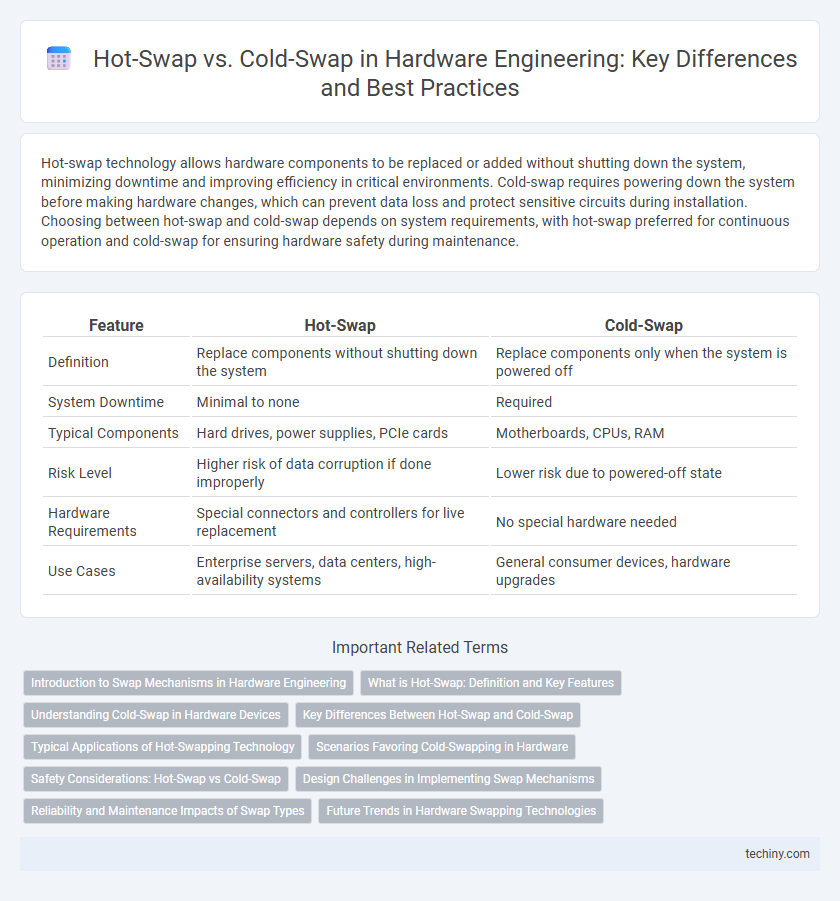Hot-swap technology allows hardware components to be replaced or added without shutting down the system, minimizing downtime and improving efficiency in critical environments. Cold-swap requires powering down the system before making hardware changes, which can prevent data loss and protect sensitive circuits during installation. Choosing between hot-swap and cold-swap depends on system requirements, with hot-swap preferred for continuous operation and cold-swap for ensuring hardware safety during maintenance.
Table of Comparison
| Feature | Hot-Swap | Cold-Swap |
|---|---|---|
| Definition | Replace components without shutting down the system | Replace components only when the system is powered off |
| System Downtime | Minimal to none | Required |
| Typical Components | Hard drives, power supplies, PCIe cards | Motherboards, CPUs, RAM |
| Risk Level | Higher risk of data corruption if done improperly | Lower risk due to powered-off state |
| Hardware Requirements | Special connectors and controllers for live replacement | No special hardware needed |
| Use Cases | Enterprise servers, data centers, high-availability systems | General consumer devices, hardware upgrades |
Introduction to Swap Mechanisms in Hardware Engineering
Hot-swap mechanisms allow hardware components to be replaced or added without shutting down the system, minimizing downtime and ensuring continuous operation. Cold-swap requires powering down the equipment before removing or installing components, which can increase system downtime but reduces the risk of electrical damage. Understanding the trade-offs between hot-swap and cold-swap methods is crucial for designing robust and maintainable hardware systems.
What is Hot-Swap: Definition and Key Features
Hot-swap refers to the ability to replace or add components, such as hard drives or power supplies, without shutting down the entire system, ensuring continuous operation. Key features include real-time detection, automatic configuration, and minimal disruption to system performance, which are essential for mission-critical hardware environments. This capability enhances system uptime and simplifies maintenance in data centers and enterprise hardware setups.
Understanding Cold-Swap in Hardware Devices
Cold-swap in hardware devices refers to the process of disconnecting or connecting components while the system is powered off, minimizing the risk of electrical damage and data corruption. This method is commonly used for components that lack hot-swapping capabilities, ensuring device safety by preventing inrush currents and static discharges. Cold-swap procedures are essential in maintenance scenarios where system downtime is acceptable and hardware reliability is prioritized.
Key Differences Between Hot-Swap and Cold-Swap
Hot-swap allows the replacement or addition of hardware components like hard drives or power supplies without shutting down the system, minimizing downtime and maintaining continuous operation. Cold-swap requires the system to be powered off before removing or installing components, ensuring safety but causing system interruptions. Key differences include operational state during replacement, impact on system availability, and hardware design complexities supporting either swapping method.
Typical Applications of Hot-Swapping Technology
Hot-swap technology is primarily used in server environments, network equipment, and data storage systems, enabling components like hard drives, power supplies, and memory modules to be replaced without shutting down the system. This capability ensures continuous operation, minimizes downtime, and supports high availability in critical infrastructure, such as data centers and enterprise servers. Hot-swapping is also common in telecommunications and industrial control systems where uninterrupted performance is essential.
Scenarios Favoring Cold-Swapping in Hardware
Cold-swapping is favored in hardware scenarios involving sensitive electronic components that require complete power-down to prevent damage or data corruption, such as during motherboard replacements or BIOS updates. It is essential in environments with legacy systems lacking hot-swap capabilities and where safety protocols mandate full power isolation before component removal. Cold-swapping ensures hardware integrity and reduces the risk of electrical shorts or hardware failure in critical infrastructure setups.
Safety Considerations: Hot-Swap vs Cold-Swap
Hot-swap technology enables the removal and replacement of hardware components while the system remains powered, reducing downtime but requiring robust circuit protection and signal integrity measures to prevent damage from electrical transients. Cold-swap mandates powering down the system before hardware changes, minimizing the risk of electrical shock and data corruption but increasing overall downtime and maintenance windows. Safety considerations for hot-swap include implementing inrush current limiters, solid-state relays, and fail-safe design features to ensure operator protection and system stability during live component swaps.
Design Challenges in Implementing Swap Mechanisms
Design challenges in implementing hot-swap mechanisms primarily involve managing inrush current and ensuring signal integrity during live component insertion or removal, requiring robust circuit protection and real-time monitoring systems. Cold-swap designs face fewer complexity issues but demand careful power sequencing and mechanical robustness to prevent damage during powered-off swaps. Both approaches necessitate precise connector design and thermal management to maintain system reliability and longevity under varying operational conditions.
Reliability and Maintenance Impacts of Swap Types
Hot-swap technology significantly enhances reliability by enabling hardware components to be replaced or added without shutting down the entire system, reducing downtime and minimizing the risk of data loss or corruption during maintenance. Cold-swap requires system power-off, increasing the likelihood of prolonged outages and potential wear on connectors due to repeated power cycling. Maintenance workflows benefit from hot-swap capabilities through faster serviceability and continuous operation, whereas cold-swap operations demand scheduled downtime, impacting availability and increasing maintenance windows.
Future Trends in Hardware Swapping Technologies
Emerging hardware swapping technologies emphasize advanced hot-swap capabilities with increased resilience to electrical noise and improved fault tolerance, enabling seamless component replacements in live systems. Integration of AI-driven diagnostics and predictive maintenance tools enhances hot-swap efficiency by minimizing downtime and preventing hardware failures proactively. Future trends anticipate widespread adoption of modular designs supporting both hot-swap and cold-swap operations with enhanced automation and interoperability across diverse hardware environments.
Hot-swap vs Cold-swap Infographic

 techiny.com
techiny.com